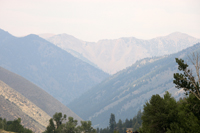Wildland fires burning in Idaho have consumed an area approaching the size of Rhode Island, and air quality has suffered.
That hazy air drifting through the Wood River Valley this past week is smoke being blown north by big fires, and it has reduced measurable air quality at the monitoring site closest to the Wood River Valley.
"This morning (Friday) in Twin Falls it (air quality) is just barely good," said Steve Van Zandt, air quality science officer with the Idaho Department of Environmental Quality. "These fires in the area are negatively affecting our air quality."
While over the weekend levels were higher they can fluctuate a lot from hour to hour.
One area resident said the deteriorating air quality had bothered her.
"I noticed it yesterday when I was biking," said Caroline Woodham, 43, of Ketchum. "It was almost like a burning in my throat." Other residents said the smoke had not bothered them.
Air quality is measured nationally with the Air Quality Index established by the federal Environmental Protection Agency. Pollution readings are translated into six air quality categories: good, moderate, unhealthy for sensitive individuals, unhealthy, very unhealthy and hazardous.
On Friday, July 20, at the closest air quality monitoring station to the Wood River Valley, located in Twin Falls, particulant matter, also known as particle pollution, registered just barely good, said Van Zandt.
"It was pretty bad for awhile over the weekend," he said, deteriorating into the moderate category. On Tuesday morning the index measured at the "low end of moderate," he said.
"Moderate" air quality means "sensitive people should plan strenuous outside activities when air quality is better," according to the state DEQ Web site.
The particulate matter is mainly smoke. Each pollutant particle is equal in size to 1/28th the diameter of a human hair, said Van Zandt.
"It's (particle pollution) so small that they (smoke microns) are readily breathed into the lungs," he said. "They have health impacts for anybody with respiratory problems, anybody with asthma or emphysema." The old and very young are more susceptible to the current air quality levels, according to Van Zandt. "What's really bad is the really really small stuff."
As of Tuesday, July 24, there were 14 large wildfires burning in Idaho. Two of those were new, and one had been contained, according to the Boise-based National Interagency Fire Center Web site. Those fires have consumed 840,488 acres.
The Murphy Complex fire, which includes the previously reported Rowland and Elk Mountain Fires 56 miles southwest of Twin Falls at 562,278 acres, is bringing the hazy smoke into the Wood River Valley, said Van Zandt. Areas of smoke in southern Idaho can be expected for "an indefinite period," he said.
The Idaho Department of Environmental Quality monitors the smoke situation statewide to protect public health, said Mike McGown, the department's smoke management coordinator. McGown monitors fire and weather information to "see where the fires are going and which way the wind is blowing." State law gives the department the authority to outlaw all forms of open burning, he said.
Currently crop field burning for fields such as wheat stubble and grass are not allowed. Weed burning is allowed if there are no fire restrictions, said Van Zandt. People should check with their local fire authorities for current permitting conditions.
Standards called National Ambient Air Quality Standards were established under the federal Clean Air Act which Congress passed in 1963 and updated in 1970 and 1990. As a rule of thumb, said Van Zandt, "If the visibility (in an area) is under two miles there should be an air stagnation alert" meaning people should stay indoors and reduce their outdoor activities.
Van Zandt has only seen that happen a couple of times in the 13 years he has been on the job. Even if the air quality does not reach "stagnation" levels, less serious air quality conditions including the "moderate" or "unhealthy for sensitive individuals" categories mean people should consider reducing outdoor activities, he said.


 Hazy air like that hovering over the northern Wood River Valley on Tuesday can cause respiratory problems. Fires burning throughout the West are contributing to widespread smoke. Photo by David N. Seelig
Hazy air like that hovering over the northern Wood River Valley on Tuesday can cause respiratory problems. Fires burning throughout the West are contributing to widespread smoke. Photo by David N. Seelig



































